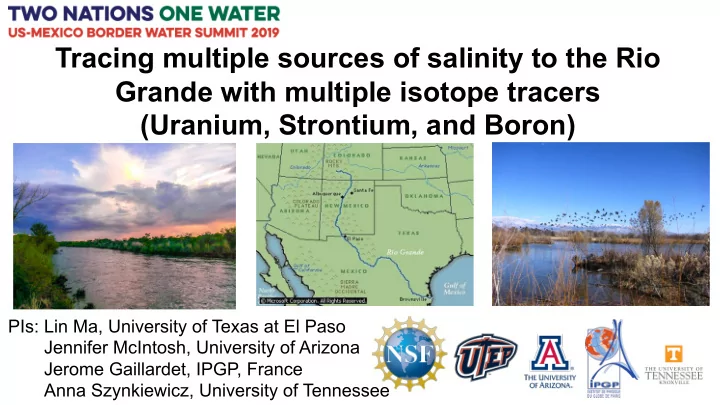

Tracing multiple sources of salinity to the Rio Grande with multiple isotope tracers (Uranium, Strontium, and Boron) PIs: Lin Ma, University of Texas at El Paso Jennifer McIntosh, University of Arizona Jerome Gaillardet, IPGP, France Anna Szynkiewicz, University of Tennessee
Complex surface-groundwater interactions and multiple salinity sources in Rio Grande: geological, agricultural, and urban impacts To combine a set of environmental tracers to fingerprint and accurately quantify salt loads from natural and anthropogenic sources in the semi- arid Rio Grande watershed. Agricultural sources (U isotopes); Urban environments (B isotopes); Deep basin brine and geothermal water (Sr, B, and U) . Conceptual Diagram from Hargrove et al., 2013
Overview of Rio Grande river salinity during our project period (2014-2017)
Preliminary findings with our isotope tracer approach: 1) All three sources (geology, agriculture, and urban) were present in Rio Grande, especially during the non-irrigation and low flow seasons; 2) Sources are highly variable both spatially and temporally; 3) Monte-Carlo inverse calculations with U, Sr, and B isotope ratios can effectively quantify salinity contributions. 100% During non-irrigation/low flow seasons Percentage contributed to Rio Grande 90% El Paso Las Cruces 80% 70% EBR 60% T or C Agriculture 50% Deep GW Shallow GW 40% Urban 30% 20% 10% 0% RG at WB RG at NM187 RG at NM 154 RG at NM 359 RG at 273
Some take-home messages: • Geological, agricultural, and urban processes contribute to salinity in Rio Grande; • Shallow groundwater in the Rio Grande region is impacted by irrigation and urban water uses; • The multi-isotope tracer approach (U, Sr, and B) is effective in identifying and quantifying salinity sources and possible contaminants (U, As, NO 3 etc.) for river and groundwater quality in our region.
Recommend
More recommend